Sliding wardrobe in a small hallway: types, selection and placement
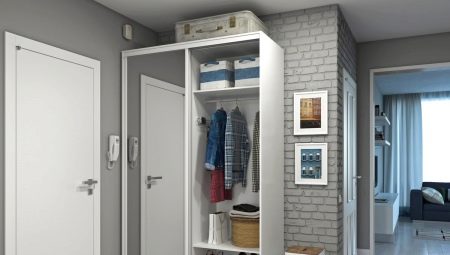
The indisputable advantages of sliding wardrobes are reliability and ease of use, as well as an attractive design. But the main thing is that with their help you can use the space more rationally. This furniture is ideal for small spaces, in particular hallways.
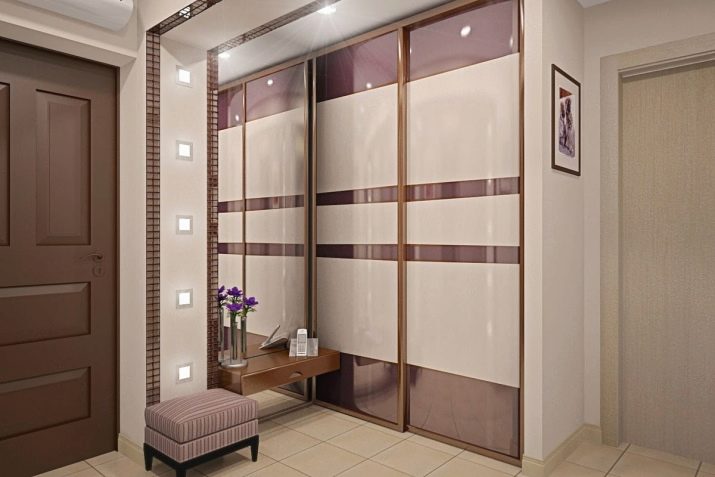
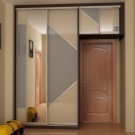


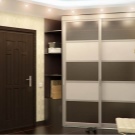
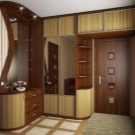
Types of structures
Sliding wardrobes are not uncommon these days. However, few people know that the choice of wardrobes with sliding doors is quite wide. There are two main types.
- Freestanding (cabinet) cabinetshaving their own frame, consisting of a bottom, top, sidewalls and a back wall. They can be collected in any part of the hallway, as well as, if necessary, moved to another place.
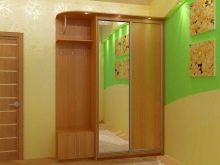
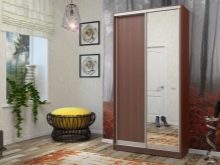

- Built-in. In them, frame parts replace the walls, floor and ceiling of the hallway - to them, in turn, partitions and shelves are attached. There are also partially built-in models. Built-in wardrobes are usually custom made and can only be moved to another room if it is the same size.

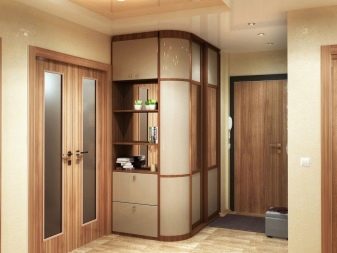
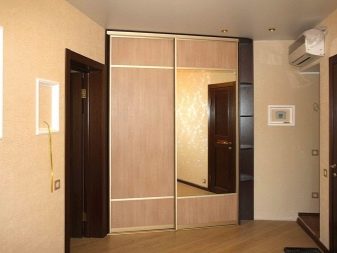
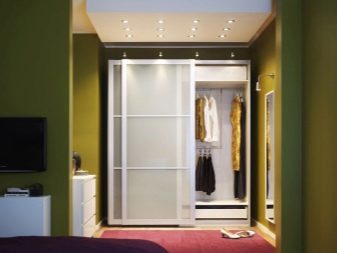
- The cabinet can be standard or modular. Typical models with standard sizes and filling do not need a long search, and they are much cheaper. Modular represent a whole system, the individual parts of which can be selected based on your own needs and preferences. The cost will depend on the complexity of the final product.
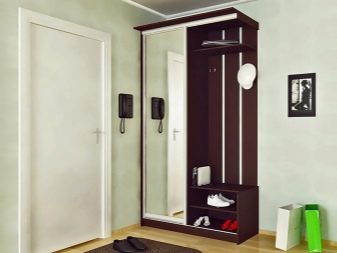
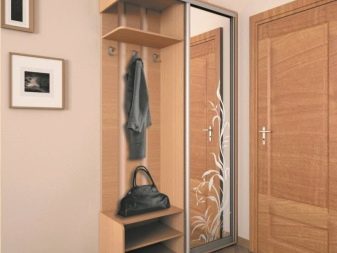
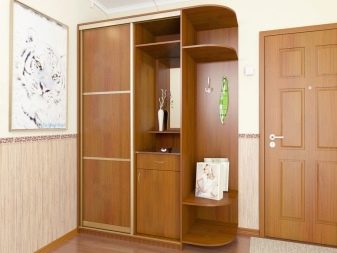
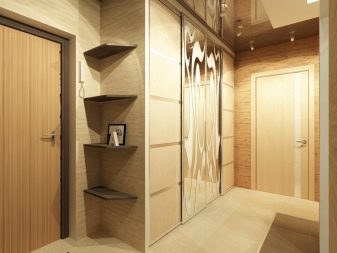
Straight and angular models are distinguished in shape.
- Straight. They can be placed along any wall or used as a partition.
- Corner. They can consist of one corner module or additional docking modules on one or both sides. Corner cabinets, in turn, are subdivided into:
- diagonal (triangular);
- trapezoidal.
Sliding wardrobe doors can move sideways due to guides and rollers. There are systems with top suspension, but the frame from the top and bottom profile is more reliable. Steel or aluminum is most often used here. The service life of the cabinet depends on the quality of the profile and the reliability of all structural details.



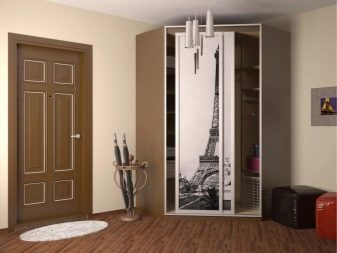
Dimensions (edit)
There are no standard sizes for wardrobes. Of course, some manufacturers have their own dimensional grid. This is more typical for mass production. Most firms have a custom-made service. At the same time, a consultant or designer records in detail all the technical characteristics and draws up a project taking into account:
- the size of the hallway;
- architectural features of the walls (the presence of protrusions, boxes, pipes, heating devices, and so on);
- customer preferences.
In addition, the purpose of the cabinet must be taken into account. Usually, outerwear, shoes and some accessories - bags, umbrellas and more are stored in the hallway. But often, when there is not enough space in living rooms, you need to find a place for other things in it. At the same time, do not forget that the hallway space is rather limited. The easiest option is to make the cabinet as tall as possible. It is optimal to occupy the entire space from floor to ceiling - usually this figure varies from 220 cm to 250 cm. In addition, the absence of a gap under the ceiling will eliminate the constant accumulation of dust.
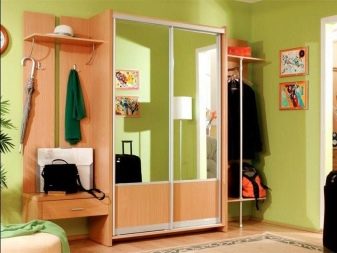

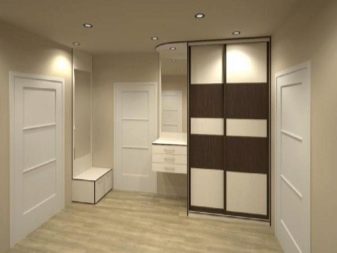
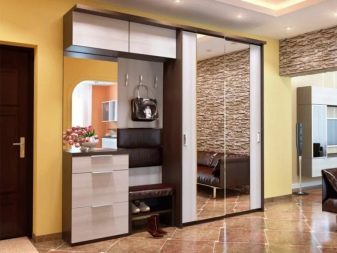
If a place for outerwear is planned in the closet, it is wiser to place it on hangers and a special bar. For this, the depth of the furniture product must be at least 60 cm. It should be borne in mind that several centimeters of the interior space will be hidden by the opening system. In a narrow hallway, when the depth decreases, you can change the hangers to less wide ones, and replace the longitudinal bar with two transverse or hooks.
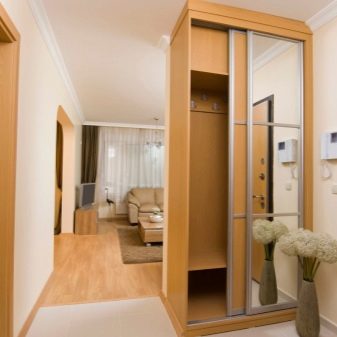
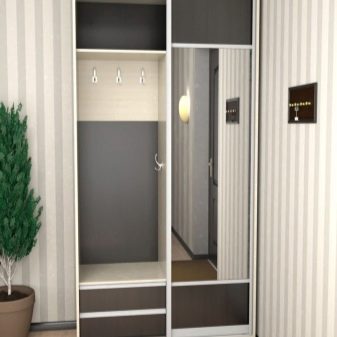
Corner modules are considered the most spacious. After all, their depth can reach a meter. This is the best solution for placing bulky items - boxes or suitcases. But their filling in the form of shelves, boxes and other compartments should be thought out as carefully as possible. The back walls of such a product do not have to be equal. For a small hallway, their length varies from 90 to 120 cm. You can make them larger, but then the depth will also increase, respectively, the passage to the apartment and the place for removing clothes will narrow.
For so that a straight wardrobe can accommodate several jackets, shoes and a few things on the shelves, its length should be at least 100-120 cm... The number of doors also depends on this parameter. There will be two of them in the small hallway. For three doors, the length of the product should be 180 cm.
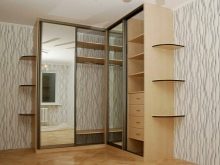
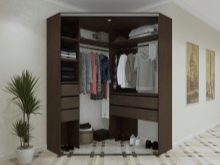

Appearance
The beauty of a wardrobe depends on several details. In the first place, of course, is the appearance of the facades (doors). Since there must be a mirror in the hallway, most often it is moved to the cabinet and the doors are mirrored in whole or in part. The mirror can be both familiar to us and tinted. A more interesting option is a sprayed mirror (for example, with patterns).
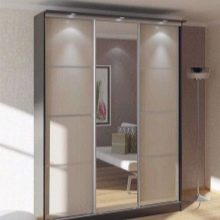
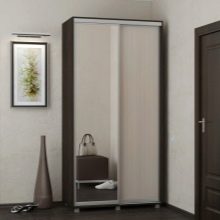
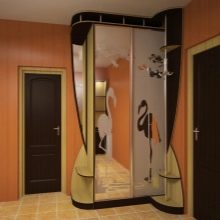
In addition to mirrors, glass is often used to decorate facades. There are several varieties that can be glossy or matte. The glass can be translucent (the contents will be slightly visible) or completely opaque. Glossy facades with a rich color palette are especially popular - you can choose both bright and discreet options. An alternative to glass is plastic (for example, acrylic). At first glance, it is difficult to distinguish them - they can completely coincide in shine, texture and color. However, the advantage of such facades, in addition to external beauty, is safety, lightness and strength.
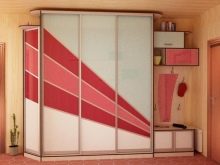
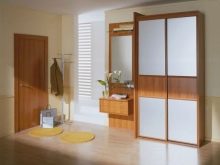
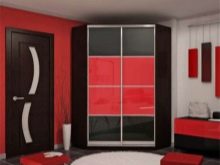
A modern interior is most often complemented by photo printing - it really gives room for imagination. Since the doors of the wardrobe are quite wide and do not have handles, they are ideal for this.The subject matter of the images can be different - city landscapes, plants, animals and other objects of animate and inanimate nature.
Typically, a drawing is selected from a catalog, but if you wish, it can be a good quality picture taken with your own hands.
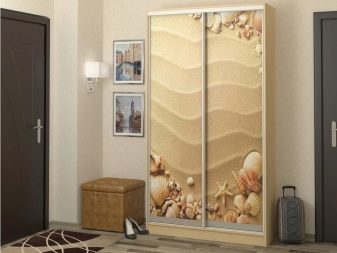

It is believed that wardrobes are more suitable for modern style, but this is not so. An invariable classic in the manufacture of hallway furniture is natural wood, as well as materials with imitation coating (MDF). Depending on the interior, both light and dark wood shades are used. Facades in this case can be smooth or frame. Depending on the style, a wooden sliding wardrobe can be supplemented with a cornice or other decorative details, but in a small hallway it is better to do without them. In addition to wood textures, rattan and bamboo are often used for sliding doors - they attract attention with their original beauty and naturalness.
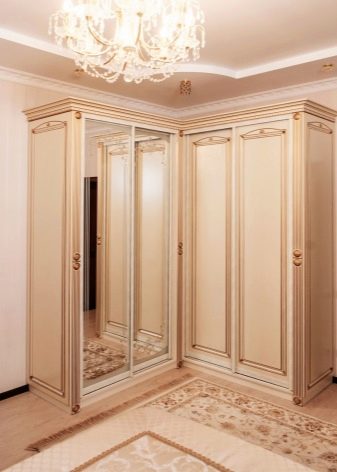
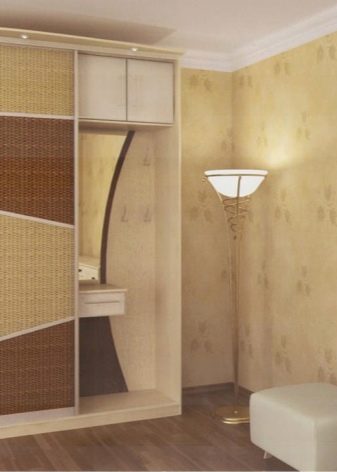
In addition to straight facades, there are also radius facades (concave or curved), with varying degrees of curvature. They can only be made from materials that can bend, so they will look the same - with or without shine, colored, with images.
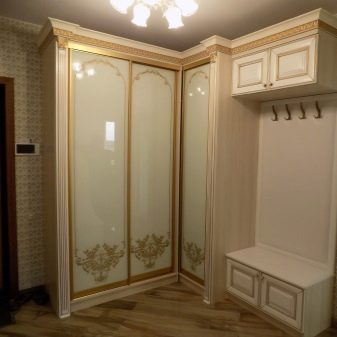

Facades can be completely made of one material or combined with others. In this case, the entire front of the cabinet is divided into parts in accordance with a certain idea - horizontally, diagonally or in a chaotic manner. Most often, the lower and upper sector is filled with one material, and the central one with another. Less attention is paid to the frame. Its color gamut is usually quite limited. Therefore, a color close to the facade or contrasting is selected for it. It will be better if the visible parts of the frame are combined with doors, skirting boards, flooring or any other covering.

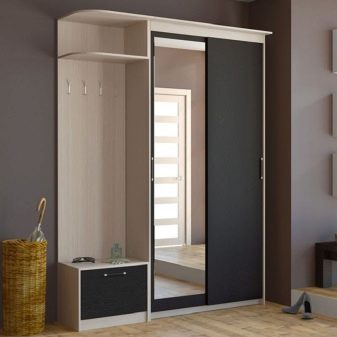
How to choose?
To quickly make a choice without spending a lot of time on it, you need to figure out in advance the main characteristics of the future cabinet.
- The size. First of all, it will depend on the hallway itself. It is necessary to set aside an area for storing things in it. If the size does not correspond to the standard offer, it is worth looking for custom made according to individual parameters. It is better to use the free space to the maximum, because there is no extra storage space.
- Material. Not only the strength, reliability and safety of the finished product depends on the material, but also its appearance. Not all materials can be used for curved facades.
- Appearance. All cabinet details should be combined not only with each other, but also with the rest of the decoration. In the color palette, you should choose three primary colors for this. In doing so, you need to carefully select shiny and textured surfaces.
- Filling. Inside, the wardrobe can consist of a variety of compartments - with a bar, drawers, shelves for clothes, a housekeeper, a shoe rack, umbrella stands and hooks for bags. Of course, this should ideally be so, but it is simply impossible to fit all this in a small hallway. Therefore, you should consider what things should be left at the entrance, divide them into groups and allocate appropriate places. For small items, it is better to use baskets or containers instead of boxes.
- Manufacturer. Modern firms provide a wide range of services - from drawing up a design project to installation. In addition to positive reviews, an additional plus will be a long warranty for the furniture.
- Price. It certainly has to match the quality of the product. To get started, just look at the prices for similar products in several companies. If somewhere a wardrobe will cost several times cheaper, you should be on your guard. Most often, they save on fittings. After a few months of use, the doors will open poorly, or even stop functioning altogether.
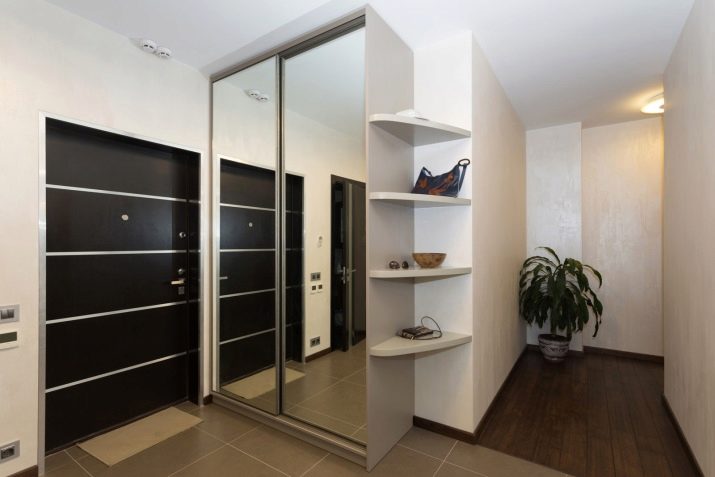
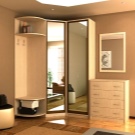
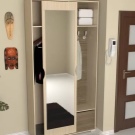
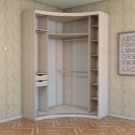
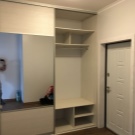
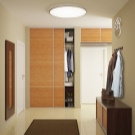
Where is it better to place?
Despite the fact that we are considering only a small hallway, the wardrobe can be placed in it in different ways.Of course, a lot here depends on the configuration of the room. For an elongated hallway, a straight wardrobe is suitable, while it must be placed along one of the walls. If the hallway is square, and there is a free corner in it, you can consider both a straight and a corner option, which is the most ergonomic. When choosing a corner model, the shape is important - the trapezoidal cabinet is more spacious, but the semicircular one will look more compact and streamlined. If there is a niche in the hallway, or it is combined with a pantry, this must certainly be used. The built-in option is the most efficient way to save space.
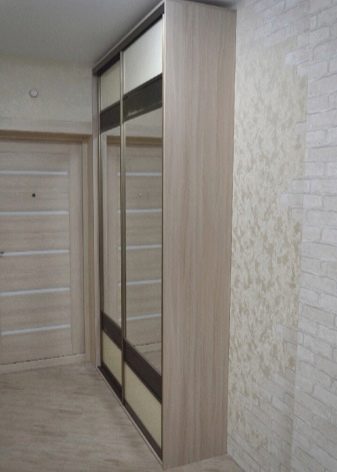
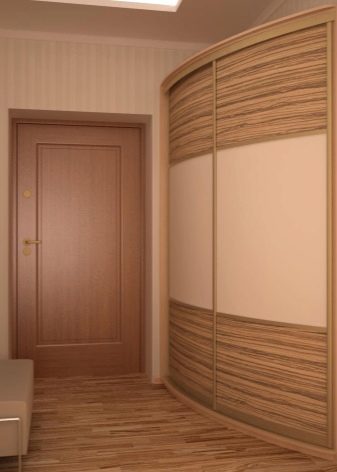
The best option is to place the cabinet directly next to the door. Such an arrangement will be not only convenient, but also hygienic - you can quickly put all things in the closet and you do not need to walk in the hallway to undress. A wardrobe with a rounding is especially convenient here - so the corners do not pose any danger, do not attract undue attention and facilitate the passage to other rooms.
To make the hallway seem as spacious as possible, the furniture can simply be removed from the line of sight. For example, place everything you need along a wall with an entrance door.
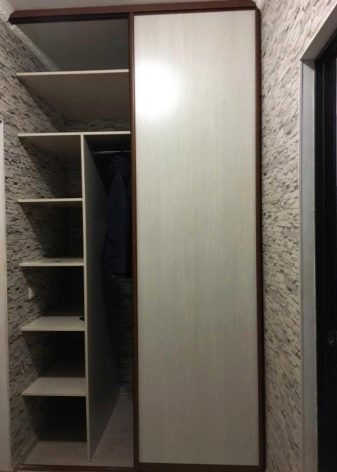

In addition to the mirror, a seating should be provided in the hallway. It can be an ottoman, sofa or bench. Built into the closet, it will save space and look more organic than usual. Very often, a wardrobe is just a module in a furniture set. In addition, if the hallway smoothly flows into another room, it is selected in the same way as the rest of the interior. It is important that the hallway does not stand out from the general style of the apartment, because the first impression of the guests depends on it.
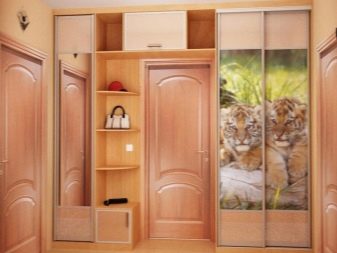
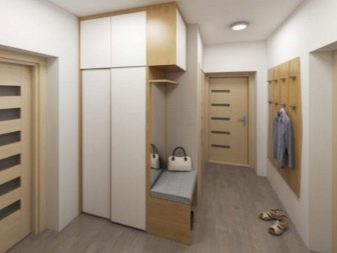
For a small hallway-corridor, the best solution would be a wardrobe with mirrors across the entire area of the facades. This will not only visually expand the boundaries of the room, but also add lighting, since the mirror surface reflects light well. For the same purpose, use gloss and any light shades. It is better to place such furniture opposite the door or across the entire width of the side wall.
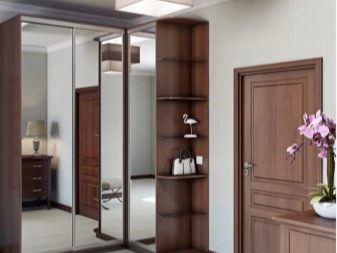
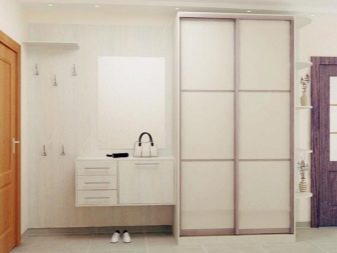
How to choose a wardrobe, see the video.








